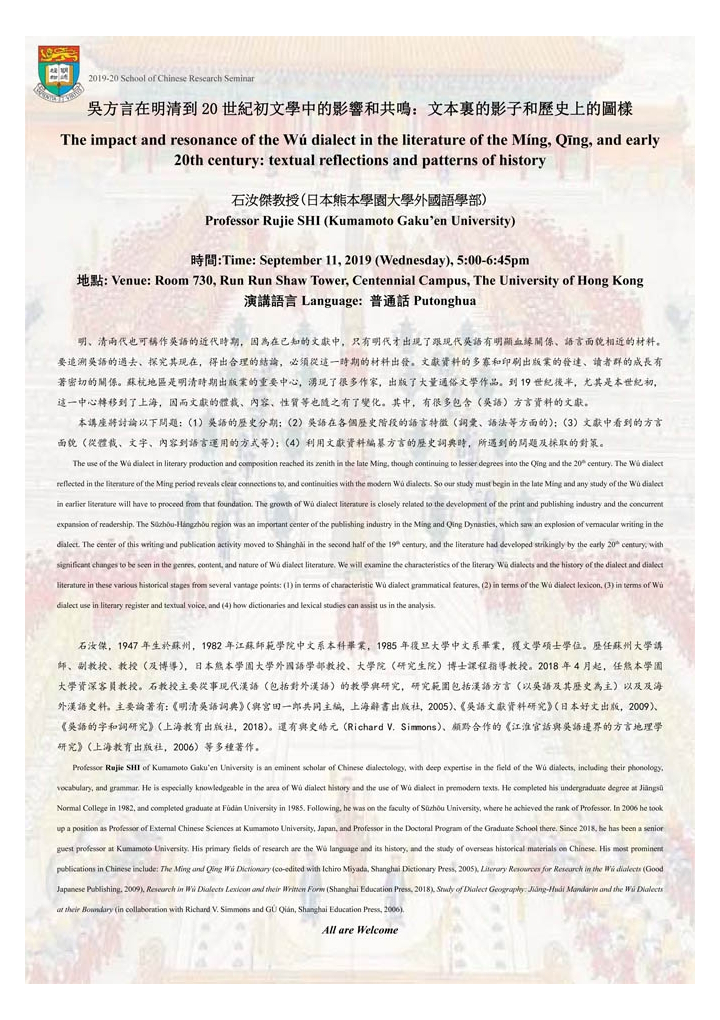吳方言在明清到20世紀初文學中的影響和共鳴:文本裏的影子和歷史上的圖樣

School of Chinese Seminar
石汝傑教授(日本熊本學園大學外國語學部)
Professor Rujie SHI (Kumamoto Gaku’en University)
吳方言在明清到20世紀初文學中的影響和共鳴:文本裏的影子和歷史上的圖樣
The impact and resonance of the Wú dialect in the literature of the Míng, Qīng, and early 20th century: textual reflections and patterns of history
時間:Time: September 11, 2019 (Wednesday), 5:00-6:45pm
地點: Venue: Room 730, Run Run Shaw Tower, Centennial Campus, The University of Hong Kong
演講語言Language: 普通話Putonghua
明、清兩代也可稱作吳語的近代時期,因為在已知的文獻中,只有明代才出現了跟現代吳語有明顯血緣關係、語言面貌相近的材料。要追溯吳語的過去、探究其現在,得出合理的結論,必須從這一時期的材料出發。文獻資料的多寡和印刷出版業的發達、讀者群的成長有著密切的關係。蘇杭地區是明清時期出版業的重要中心,湧現了很多作家,出版了大量通俗文學作品。到19世紀後半,尤其是本世紀初,這一中心轉移到了上海,因而文獻的體裁、內容、性質等也隨之有了變化。其中,有很多包含(吳語)方言資料的文獻。
本講座將討論以下問題:(1)吳語的歷史分期;(2)吳語在各個歷史階段的語言特徵(詞彙、語法等方面的);(3)文獻中看到的方言面貌(從體裁、文字、內容到語言運用的方式等);(4)利用文獻資料編纂方言的歷史詞典時,所遇到的問題及採取的對策。
The use of the Wú dialect in literary production and composition reached its zenith in the late Míng, though continuing to lesser degrees into the Qīng and the 20th century. The Wú dialect reflected in the literature of the Míng period reveals clear connections to, and continuities with the modern Wú dialects. So our study must begin in the late Míng and any study of the Wú dialect in earlier literature will have to proceed from that foundation. The growth of Wú dialect literature is closely related to the development of the print and publishing industry and the concurrent expansion of readership. The Sūzhōu-Hángzhōu region was an important center of the publishing industry in the Míng and Qīng Dynasties, which saw an explosion of vernacular writing in the dialect. The center of this writing and publication activity moved to Shànghǎi in the second half of the 19th century, and the literature had developed strikingly by the early 20th century, with significant changes to be seen in the genres, content, and nature of Wú dialect literature. We will examine the characteristics of the literary Wú dialects and the history of the dialect and dialect literature in these various historical stages from several vantage points: (1) in terms of characteristic Wú dialect grammatical features, (2) in terms of the Wú dialect lexicon, (3) in terms of Wú dialect use in literary register and textual voice, and (4) how dictionaries and lexical studies can assist us in the analysis.
石汝傑,1947年生於蘇州,1982年江蘇師範學院中文系本科畢業,1985年復旦大學中文系畢業,獲文學碩士學位。歷任蘇州大學講師、副教授、教授(及博導),日本熊本學園大學外國語學部教授、大學院(研究生院)博士課程指導教授。2018年4月起,任熊本學園大學資深客員教授。石教授主要從事現代漢語(包括對外漢語)的教學與研究,研究範圍包括漢語方言(以吳語及其歷史為主)以及及海外漢語史料。主要論著有:《明清吳語詞典》(與宮田一郎共同主編,上海辭書出版社,2005)、《吳語文獻資料研究》(日本好文出版, 2009)、《吳語的字和詞研究》(上海教育出版社,2018)。還有與史皓元(Richard V. Simmons)、顧黔合作的《江淮官話與吳語邊界的方言地理學研究》(上海教育出版社,2006)等多種著作。
Professor Rujie SHI of Kumamoto Gaku’en University is an eminent scholar of Chinese dialectology, with deep expertise in the field of the Wú dialects, including their phonology, vocabulary, and grammar. He is especially knowledgeable in the area of Wú dialect history and the use of Wú dialect in premodern texts. He completed his undergraduate degree at Jiāngsū Normal College in 1982, and completed graduate at Fùdàn University in 1985. Following, he was on the faculty of Sūzhōu University, where he achieved the rank of Professor. In 2006 he took up a position as Professor of External Chinese Sciences at Kumamoto University, Japan, and Professor in the Doctoral Program of the Graduate School there. Since 2018, he has been a senior guest professor at Kumamoto University. His primary fields of research are the Wú language and its history, and the study of overseas historical materials on Chinese. His most prominent publications in Chinese include: The Míng and Qīng Wú Dictionary (co-edited with Ichiro Miyada, Shanghai Dictionary Press, 2005), Literary Resources for Research in the Wú dialects (Good Japanese Publishing, 2009), Research in Wú Dialects Lexicon and their Written Form (Shanghai Education Press, 2018), Study of Dialect Geography: Jiāng-Huái Mandarin and the Wú Dialects at their Boundary(in collaboration with Richard V. Simmons and GÙ Qián, Shanghai Education Press, 2006).
All Welcome









